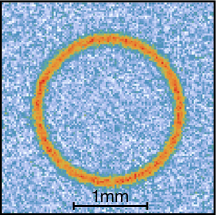To: 29/01/2020 14:00
 The aim of this presentation is to explain our recent Nature paper to the non-specialists in our institute [1].
The aim of this presentation is to explain our recent Nature paper to the non-specialists in our institute [1].
Hopefully, this will enable anyone interested to understand the basic idea, its background in the field (and beyond), future applications and fundamental implications.
Bose-Einstein Condensation (BEC) is to atoms what the laser is to photons: A massively occupied coherent quantum wave, which we can create and manipulate with unprecedented precision. In order to exploit these states, we have to be able to store and transport them. Just like light, matterwaves are difficult to transmit over long distances without major losses. The solution for the problem for light is the optical fiber, which over the past twenty years has proven to be a very elusive goal. In this talk, we will show the first demonstration of coherent matterwave-guiding over macroscopic distances without adversely affecting their coherence.
Applications of this novel waveguide are matterwave interferometers, which carry the promise of much increased sensitivity and stability (when compared to their light-based cousins) and much decreased size (when compared to free-space atom-based systems). The increase in sensitivity can be exploited in the climate science (water resources monitoring) or mineral/oil exploration and exploitation.
References
[1] Hypersonic Bose--Einstein condensates in accelerator rings. Saurabh Pandey, Hector Mas, Giannis Drougakis, Premjith Thekkeppatt, Vasiliki Bolpasi, Georgios Vasilakis, Konstantinos Poulios, and Wolf von Klitzing Nature 570:7760 205-209 (2019).
[2] Thilo Schuldt et al. Picometer and nanoradian optical heterodyne interferometry for translation and tilt metrology of the LISA gravitational reference sensor Classical and Quantum Gravity 268 085008 (2009)
[3] J.L. Hall, J. Ye, and L.S. Ma Measurement of mirror birefringence at the sub-ppm level: Proposed application to a test of QED Physical Review A 62 1 13815 (2000)


